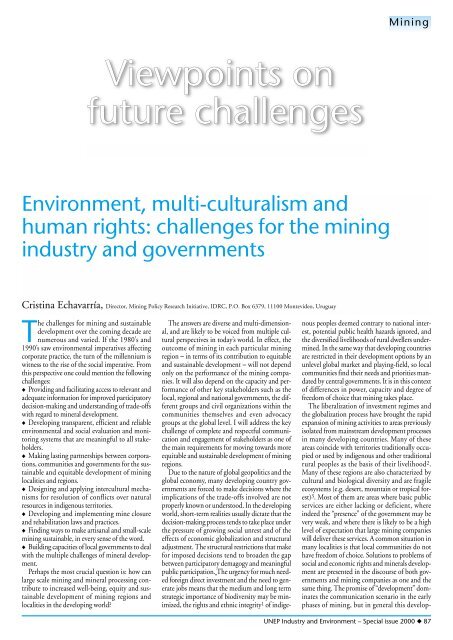Mining and Sustainable Development II - DTIE
Mining and Sustainable Development II - DTIE
Mining and Sustainable Development II - DTIE
Create successful ePaper yourself
Turn your PDF publications into a flip-book with our unique Google optimized e-Paper software.
<strong>Mining</strong><br />
Viewpoints on<br />
future challenges<br />
Environment, multi-culturalism <strong>and</strong><br />
human rights: challenges for the mining<br />
industry <strong>and</strong> governments<br />
Cristina Echavarría, Director, <strong>Mining</strong> Policy Research Initiative, IDRC, P.O. Box 6379, 11100 Montevideo, Uruguay<br />
The challenges for mining <strong>and</strong> sustainable<br />
development over the coming decade are<br />
numerous <strong>and</strong> varied. If the 1980’s <strong>and</strong><br />
1990’s saw environmental imperatives affecting<br />
corporate practice, the turn of the millennium is<br />
witness to the rise of the social imperative. From<br />
this perspective one could mention the following<br />
challenges:<br />
◆ Providing <strong>and</strong> facilitating access to relevant <strong>and</strong><br />
adequate information for improved participatory<br />
decision-making <strong>and</strong> underst<strong>and</strong>ing of trade-offs<br />
with regard to mineral development.<br />
◆ Developing transparent, efficient <strong>and</strong> reliable<br />
environmental <strong>and</strong> social evaluation <strong>and</strong> monitoring<br />
systems that are meaningful to all stakeholders.<br />
◆ Making lasting partnerships between corporations,<br />
communities <strong>and</strong> governments for the sustainable<br />
<strong>and</strong> equitable development of mining<br />
localities <strong>and</strong> regions.<br />
◆ Designing <strong>and</strong> applying intercultural mechanisms<br />
for resolution of conflicts over natural<br />
resources in indigenous territories.<br />
◆ Developing <strong>and</strong> implementing mine closure<br />
<strong>and</strong> rehabilitation laws <strong>and</strong> practices.<br />
◆ Finding ways to make artisanal <strong>and</strong> small-scale<br />
mining sustainable, in every sense of the word.<br />
◆ Building capacities of local governments to deal<br />
with the multiple challenges of mineral development.<br />
Perhaps the most crucial question is: how can<br />
large scale mining <strong>and</strong> mineral processing contribute<br />
to increased well-being, equity <strong>and</strong> sustainable<br />
development of mining regions <strong>and</strong><br />
localities in the developing world?<br />
The answers are diverse <strong>and</strong> multi-dimensional,<br />
<strong>and</strong> are likely to be voiced from multiple cultural<br />
perspectives in today’s world. In effect, the<br />
outcome of mining in each particular mining<br />
region – in terms of its contribution to equitable<br />
<strong>and</strong> sustainable development – will not depend<br />
only on the performance of the mining companies.<br />
It will also depend on the capacity <strong>and</strong> performance<br />
of other key stakeholders such as the<br />
local, regional <strong>and</strong> national governments, the different<br />
groups <strong>and</strong> civil organizations within the<br />
communities themselves <strong>and</strong> even advocacy<br />
groups at the global level. I will address the key<br />
challenge of complete <strong>and</strong> respectful communication<br />
<strong>and</strong> engagement of stakeholders as one of<br />
the main requirements for moving towards more<br />
equitable <strong>and</strong> sustainable development of mining<br />
regions.<br />
Due to the nature of global geopolitics <strong>and</strong> the<br />
global economy, many developing country governments<br />
are forced to make decisions where the<br />
implications of the trade-offs involved are not<br />
properly known or understood. In the developing<br />
world, short-term realities usually dictate that the<br />
decision-making process tends to take place under<br />
the pressure of growing social unrest <strong>and</strong> of the<br />
effects of economic globalization <strong>and</strong> structural<br />
adjustment. The structural restrictions that make<br />
for imposed decisions tend to broaden the gap<br />
between participatory demagogy <strong>and</strong> meaningful<br />
public participation. The urgency for much needed<br />
foreign direct investment <strong>and</strong> the need to generate<br />
jobs means that the medium <strong>and</strong> long term<br />
strategic importance of biodiversity may be minimized,<br />
the rights <strong>and</strong> ethnic integrity 1 of indigenous<br />
peoples deemed contrary to national interest,<br />
potential public health hazards ignored, <strong>and</strong><br />
the diversified livelihoods of rural dwellers undermined.<br />
In the same way that developing countries<br />
are restricted in their development options by an<br />
unlevel global market <strong>and</strong> playing-field, so local<br />
communities find their needs <strong>and</strong> priorities m<strong>and</strong>ated<br />
by central governments. It is in this context<br />
of differences in power, capacity <strong>and</strong> degree of<br />
freedom of choice that mining takes place.<br />
The liberalization of investment regimes <strong>and</strong><br />
the globalization process have brought the rapid<br />
expansion of mining activities to areas previously<br />
isolated from mainstream development processes<br />
in many developing countries. Many of these<br />
areas coincide with territories traditionally occupied<br />
or used by indigenous <strong>and</strong> other traditional<br />
rural peoples as the basis of their livelihood 2 .<br />
Many of these regions are also characterized by<br />
cultural <strong>and</strong> biological diversity <strong>and</strong> are fragile<br />
ecosystems (e.g. desert, mountain or tropical forest)<br />
3 . Most of them are areas where basic public<br />
services are either lacking or deficient, where<br />
indeed the “presence” of the government may be<br />
very weak, <strong>and</strong> where there is likely to be a high<br />
level of expectation that large mining companies<br />
will deliver these services. A common situation in<br />
many localities is that local communities do not<br />
have freedom of choice. Solutions to problems of<br />
social <strong>and</strong> economic rights <strong>and</strong> minerals development<br />
are presented in the discourse of both governments<br />
<strong>and</strong> mining companies as one <strong>and</strong> the<br />
same thing. The promise of “development” dominates<br />
the communication scenario in the early<br />
phases of mining, but in general this develop-<br />
UNEP Industry <strong>and</strong> Environment – Special issue 2000 ◆ 87
















